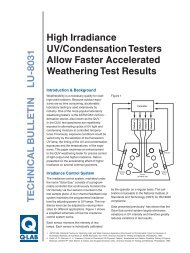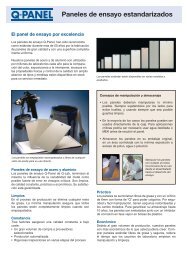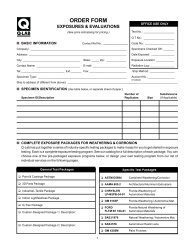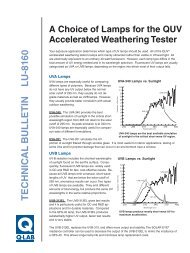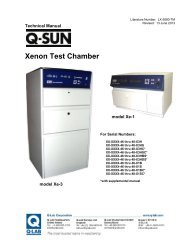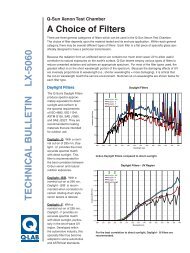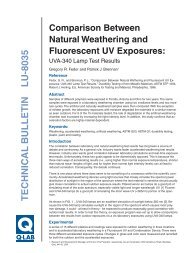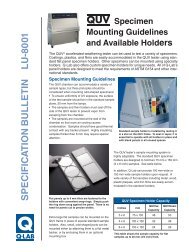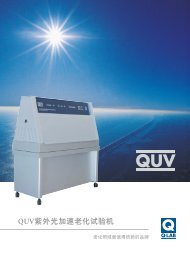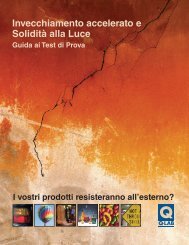QUV vs. Enclosed Carbon Arc - Q-Lab
QUV vs. Enclosed Carbon Arc - Q-Lab
QUV vs. Enclosed Carbon Arc - Q-Lab
Create successful ePaper yourself
Turn your PDF publications into a flip-book with our unique Google optimized e-Paper software.
(!1<br />
Q·PANEL<br />
LAB PRODUCTS<br />
The <strong>QUV</strong><br />
Compared 10<br />
<strong>Enclosed</strong><br />
<strong>Carbon</strong> <strong>Arc</strong><br />
Weathering is an important cause of damage to<br />
plastics, textiles, coatings, and other organic materials.<br />
Accelerated weathering testers are used to<br />
simulate this damage for research and development,<br />
quality control, and material certification.<br />
Two widely used accelerated testers are the <strong>QUV</strong><br />
(ASTM G-53) and the <strong>Enclosed</strong> <strong>Carbon</strong> <strong>Arc</strong><br />
(ASTM G-23). The testers differ in several important<br />
areas: light spectrum, method of moisture<br />
simulation, required maintenance, price and<br />
operating cost.<br />
EMISSION SPECTRA<br />
<strong>Carbon</strong> arcs were designed on the idea that, to<br />
simulate sunlight, it is necessary to reproduce the<br />
entire spectrum of sunlight. The <strong>QUV</strong> uses a<br />
different approach. <strong>QUV</strong> lamps do not attempt to<br />
reproduce sunlight itself, just the damaging effects<br />
of sunlight. This approach is effective because<br />
short wavelength UV causes almost all of the damage<br />
to durable materials exposed outdoors.<br />
Consequently, <strong>QUV</strong> lamps confine their primary<br />
emission to the UV portion of the spectrum. This<br />
results in different spectra from the carbon arc and,<br />
usually, different test results. To understand the<br />
difference between the carbon arc and the <strong>QUV</strong>,<br />
its necessary to first look at the spectrum of<br />
sunlight.<br />
2.0--.-----.,..----------,<br />
E<br />
c:<br />
:~E 1.5 : ::I'<br />
ell 1.0 ,<br />
u c: ,<br />
.!! I<br />
'tI 0.5<br />
~<br />
UVRegion<br />
0.0 -J......h-!..+ ......... ..-.-r...;..,...-.-rTM'..-.-r ....... "I"j'T ................. ..,..,.,r"""-rI<br />
250 350 450 550 650<br />
Wavelength (nanometers)<br />
Fig. 1 -<br />
The Sunlight Spectrum<br />
THE SUNLIGHT SPECTRUM<br />
The electromagnetic energy from sunlight is<br />
normally divided into ultraviolet light, visible light,<br />
and infrared energy. Figure 1 shows the spectral<br />
power distribution (SPD) of noon midsummer<br />
sunlight. Infrared energy (not shown) consists of<br />
wavelengths longer than the visible red wavelengths<br />
and starts above about 760 nanometers<br />
(nm). Visible light is defined as radiation between<br />
400 and 760 nm. Ultraviolet light consists of radiation<br />
below 400 nm. The International Commission<br />
on Illumination (CIE) further subdivides the UV<br />
portion of the spectrum into UV-A, UV-B and UV-C<br />
as shown in Figure 1.<br />
IMPORTANCE OF SHORT<br />
WAVELENGTH CUT-OFF<br />
Photochemical degradation is caused by<br />
photons of light breaking chemical bonds. For each<br />
type of chemical bond there is a critical threshold<br />
wavelength of light with enough energy to cause a<br />
reaction. Light of any wavelength shorter than the<br />
threshold can break the bond, but longer wavelengths<br />
of light cannot break it-regardless of their<br />
intensity (brightness). Therefore, the short wavelength<br />
cut-off of a light source is of critical importance.<br />
For example, if a particular polymer is only<br />
sensitive to UV light below 295 nm (the solar cutoff<br />
point), it will never experience photochemical<br />
deterioration outdoors. If the same polymer is<br />
exposed to a laboratory light source that has a<br />
spectral cut-off of 280 nm, it will deteriorate.<br />
Although light sources that produce shorter wavelengths<br />
produce faster tests, there's a possibility of<br />
anomalous results if a tester has a wavelength<br />
cut-off too far below that of the material's end use<br />
environment.<br />
Conversely, if a light source is deficient in short<br />
wavelength UV, it may not have any effect on a<br />
material that will deteriorate upon exposure to<br />
sunlight. Or the material may not degrade in the<br />
same manner (or to the same degree) as in actual<br />
service.<br />
ENCLOSED CARBON ARC SPECTRA<br />
The enclosed carbon arc has been used as a<br />
solar simulator in accelerated weathering and lightfastness<br />
testers since 1918. Many ASTM and<br />
Federal Test Methods still specify its use. When<br />
the light output of this apparatus is compared to<br />
sunlight, some deficiencies become evident.<br />
Figure 2 shows the UV spectral power distribution<br />
(SPD) of summer sunlight compared to the<br />
enclosed carbon arc. The UV output of the<br />
enclosed carbon arc primarily consists of two very<br />
large spikes of energy, with a very small amount of<br />
output below 350 nm.
1.2<br />
E<br />
-E 1.0<br />
N<br />
.€ := 0.8<br />
I<br />
QI 0.6<br />
u<br />
I:<br />
:6 0.4<br />
E<br />
.: 0.2<br />
270 290 310 330 350 370 390<br />
Wavelength (nanometers)<br />
Fig. 2 -<br />
<strong>Enclosed</strong> <strong>Carbon</strong> <strong>Arc</strong> and Sunlight<br />
Since the shortest UV wavelengths are the most<br />
damaging, the enclosed carbon arc gives very slow<br />
tests on most materials and poor correlation on<br />
materials sensitive to short wavelength UV. Figure<br />
3 shows the same SPD comparison graphed on a<br />
different vertical scale to include all of the output<br />
from the spikes.<br />
E 1.<br />
I:<br />
N'"<br />
E o.<br />
3=<br />
I o.<br />
B<br />
I:<br />
.!!! o.<br />
"tI<br />
E<br />
.!:: 0.2<br />
1.2:,----------------:-----,<br />
o<br />
<strong>Enclosed</strong> <strong>Carbon</strong> <strong>Arc</strong><br />
Sunlight ~<br />
270 290 310 330 350 370<br />
Wavelength (nanometers)<br />
Fig. 3 -<br />
<strong>Enclosed</strong> <strong>Carbon</strong> <strong>Arc</strong> and Sunlight<br />
390<br />
<strong>Carbon</strong> rods in the carbon arc have to be<br />
replaced daily. The emission spectrum may vary<br />
from carbon to carbon. This can create significant<br />
variability in results from short term tests, and it<br />
mayor may not create problems for exposures that<br />
last long enough to average out the differences in<br />
carbon output.<br />
<strong>QUV</strong> LAMP SPECTRA<br />
There are different types of <strong>QUV</strong> lamps, with<br />
different spectra, for different exposure applications.<br />
For further information see Q-Panel<br />
Bulletin LU-0816, Choice of Lamps.<br />
UV-8 Lamps<br />
UV-B lamps are the most widely used <strong>QUV</strong><br />
lamps. They have demonstrated good correlation<br />
to outdoor exposures for the gloss retention in coatings<br />
and for the material integrity of plastics. However<br />
their short wavelength output below the solar<br />
cut-off can occasionally cause anomalous results,<br />
especially for color retention of plastics and textile<br />
materials. The <strong>QUV</strong>, with UV-B lamps, will generally<br />
give significantly faster test results than an<br />
enclosed carbon arc.<br />
E 1.<br />
I:<br />
N'"<br />
E o.<br />
3=<br />
I o.<br />
B<br />
I:<br />
.!!! o.<br />
"tI<br />
E<br />
.: 0.2<br />
1.2:,----------------...."<br />
270 290 310 330 350 370 390<br />
Wavelength (nanometers)<br />
UVA Lamps<br />
Fig. 4 -<br />
UVB-313 and FS-40<br />
UV-A lamps were developed to enhance the<br />
correlation between <strong>QUV</strong> and outdoor testing.<br />
They usually give slower results than the UV-B,<br />
but are more realistic. UV-A lamps have been<br />
successfully used for testing plastics, textiles<br />
and coatings.<br />
1.2 --.------------------.<br />
1.0<br />
E<br />
I:<br />
~ 0.8<br />
3=<br />
GI 0.6<br />
u<br />
I:<br />
.!!! 0.4<br />
"tI<br />
E<br />
.: 0.2<br />
0.0 +--.--,---.-....... :.......,.--,-.---r--r--r--.---.---.--I<br />
260 280 300 320 340 360 380 400<br />
Wavelength (nm)<br />
Fig. 5 - UVA-340 and Sunlight<br />
Figure 5 shows the UVA-340 compared to Solar<br />
Maximum. This lamp is an excellent simulation of<br />
sunlight from about 365 nm, down to the solar<br />
cut-off of 295 nm.<br />
<strong>QUV</strong> IRRADIANCE CONTROL<br />
The <strong>QUV</strong> uses fluorescent UV lamps to simulate<br />
the effects of sunlight. One advantage of fluorescent<br />
lamps is their spectral stability throughout<br />
their life. In other words, although fluorescent<br />
lamps loose output (i.e. brightness) as they age,<br />
their spectrum remains essentially the same. This<br />
consistency of spectrum allows easier control of<br />
irradiance.
Figure 6 -<br />
.. N<br />
Controller<br />
... C')<br />
1i 1i 1il<br />
.!! .!! .!! 'i<br />
'iii 'ii 'ii 'iii<br />
ID ID ID ID<br />
Solar Eye Irradiance Control System<br />
The <strong>QUV</strong>'s Solar Eye irradiance control system<br />
(models <strong>QUV</strong>/se and <strong>QUV</strong>/spray) consists of a programmable<br />
controller that continuously monitors<br />
the UV intensity via four sensors mounted in the<br />
test sample plane. A four channel feedback loop<br />
system maintains the programmed irradiance level<br />
by adjusting power to UV lamps. Figure 6 shows a<br />
simplified schematic of how the irradiance control<br />
system works. With the Solar Eye, the user sets<br />
the level of desired irradiance and the Solar Eye<br />
maintains it automatically.<br />
Each sensor monitors the intensity of two lamps.<br />
Each sensor is individually calibrated by the operator<br />
on a regular basis. The calibration is traceable<br />
to the U.S. National Institute of Standards and<br />
Technology (NIST).<br />
Another advantage of the Solar Eye is that a<br />
push-button irradiance setting allows you to fix the<br />
exact irradiance level. With the UVA-340 lamp you<br />
can operate the Solar Eye at various levels for different<br />
applications and still maintain realistic test<br />
conditions. For example, as shown in Figure 8, with<br />
the UVA-340 lamps you could set the Solar Eye to<br />
simulate any of the following sunlight conditions:<br />
• Intensified 75% (higher than <strong>QUV</strong>/basic) for<br />
fast results.<br />
• Typical (equivalent to noon summer sunlight)<br />
for quick results without sacrificing correlation.<br />
This is the irradiance of a <strong>QUV</strong>/basic.<br />
• Reduced to .35 W/m2/nm at 340 nm to match<br />
so-called "Average Optimum" sunlight or<br />
Xenon.<br />
E<br />
-E 1<br />
~<br />
g<br />
.Il! 0.5<br />
1<br />
1.5...,------------------,<br />
o~----~~---------~<br />
270 290 310 330 350 370 390<br />
Wavelength (nm)<br />
Figure 7 -<br />
UVA-340 Lamps <strong>vs</strong> Sunlight<br />
Using UVB-313 lamps, you can operate at Intensified<br />
(75% higher than standard) for extremely<br />
fast tests, for Quality Control applications, or for<br />
testing very durable materials. You can also set the<br />
irradiance level to be equivalent to the QFS-40<br />
lamp and reap the benefits of greatly enhanced<br />
lamp life. (Figure 8)<br />
E<br />
c<br />
N-1<br />
.E.<br />
;:<br />
1.5...,-----------------,<br />
8<br />
c<br />
:6 0.5<br />
~<br />
°270 290 310 330 350 370 390<br />
Wavelength (nm)<br />
Figure 8 - UVB-313 Allow Fast Results<br />
THE <strong>QUV</strong>/basic AND MANUAL<br />
IRRADIANCE CONTROL<br />
The <strong>QUV</strong>/basic is the original version of the<br />
<strong>QUV</strong>. It is still widely used in labs where economy<br />
is critical. It is the same as the <strong>QUV</strong>/se, but without<br />
the automatic Solar Eye irradiance control system.<br />
With the <strong>QUV</strong>/basic irradiance is not adjustable,<br />
The <strong>QUV</strong>/basic compensates for lamp aging by a<br />
simple rotation/replacement system.<br />
Rotation System. Each tester uses eight<br />
lamps; four on each side. Irradiance is controlled<br />
by replacing the oldest lamp in each bank every<br />
400 hours of lamp operation. At that time the remaining<br />
six lamps are rotated as shown in Figure<br />
9. The irradiance is an average of lamps at four<br />
different points on the age/output curve. This average<br />
remains relatively stable over time, giving<br />
these multi-lamp testers a substantial advantage<br />
over single lamp testers.
Figure 9 -<br />
CD t<br />
CD<br />
t<br />
CD-<br />
Discard<br />
(0 -4-- New Lamp - CD<br />
Rotation/Replacement Sequence<br />
There are two inherent weaknesses in this system.<br />
First, there is no way to compensate for any<br />
lot to lot differences in lamps from manufacturing<br />
limitations. Second, because lamps deteriorate<br />
with age, there is a drop in light output between<br />
rotations. This is not significant with some lamp<br />
types. For Example, UV A-340 output drops only<br />
about 5%. However it can be very significant with<br />
other lamps. FS-40 lamp output may drop 15%.<br />
MOISTURE SIMULATION<br />
<strong>Enclosed</strong> <strong>Carbon</strong> <strong>Arc</strong><br />
The carbon arc uses a system of intermittent<br />
water spray to simulate the effects of rain and dew.<br />
There are several problems with this.<br />
• Distilled or deionized water is necessary to<br />
prevent water spotting and contamination of<br />
the test specimen.<br />
• Relatively cold water from a reservoir is<br />
sprayed on a hot sample. This causes thermal<br />
shock and rapid evaporation of the water.<br />
Moisture doesn't have time to penetrate the<br />
sample.<br />
• Water from the reservoir may be oxygen poor.<br />
<strong>QUV</strong> Moisture System<br />
The <strong>QUV</strong> uses condensation for it's moisture<br />
cycle. The <strong>QUV</strong>'s condensation cycle is more realistic<br />
and more severe than water spray for the following<br />
reasons:<br />
1. Condensation simulates outdoor moisture<br />
attack more realistically than water spray.<br />
Most outdoor wetness is caused by dew, not<br />
rain. For more information on time of wetness<br />
outdoors, see Bulletin LU-0821 , "Know your<br />
Enemy: The Weather and How to Reproduce it<br />
in the <strong>Lab</strong>oratory."<br />
2. The <strong>QUV</strong>'s condensation is at elevated<br />
temperature to accelerate moisture effects.<br />
3. The <strong>QUV</strong> allows the moisture several hours to<br />
penetrate the test specimen. A typical <strong>QUV</strong><br />
condensation cycle is 4 hours at 50°C.<br />
4. The <strong>QUV</strong>'s condensation assures water purity<br />
and oxygen saturation without cumbersome<br />
stills or deionizers.<br />
MAINTENANCE<br />
The carbon arc requires daily cleaning and carbon<br />
rod replacement. This procedure typically<br />
takes over an hour every day. Filters must be<br />
cleaned and replaced frequently. In contrast, <strong>QUV</strong><br />
maintenance requirements are about 5 minutes<br />
each month.<br />
The <strong>QUV</strong> operates automatically over weekends<br />
and holidays, 24 hours a day, 7 days a week.<br />
This translates into significantly more yearly test<br />
time than a carbon arc.<br />
COST CONSIDERATIONS<br />
Purchase Price<br />
The purchase price of a carbon arc is many<br />
times higher than that of a <strong>QUV</strong>.<br />
Operating Costs<br />
Typical operating costs for an enclosed carbon<br />
arc in constant use are approximately $5,000 per<br />
year. The <strong>QUV</strong> costs about $1000 per year if used<br />
continuously.<br />
(!1<br />
Q·PANEL<br />
LAB PRODUCTS<br />
Q·Panel <strong>Lab</strong> Products<br />
26200 First Street<br />
Cleveland,OH 44145 USA<br />
Phone: (440) 835-8700<br />
Fax: (440) 835-8738<br />
European Branch:<br />
Q·Panel <strong>Lab</strong> Products<br />
Express Trading Estate<br />
Farnworth, Bolton<br />
England BL49TP<br />
Phone: (01204) 861616<br />
Fax: (01204) 861617<br />
LU·SOOS<br />
© 1994 Q·Panel <strong>Lab</strong> Products.<br />
All Rights Reserved.



